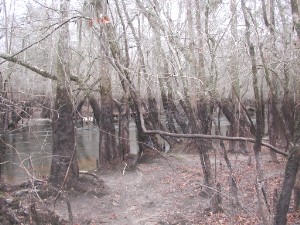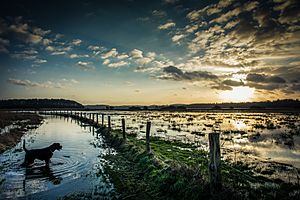Floodplain facts for kids
A floodplain is a flat area of land next to a river. It stretches from the river banks to the edges of the valley. These areas get covered with water when the river floods during heavy rains or snowmelt. The soil in floodplains is usually made of rich silt, sand, and clay. These materials are left behind by the floodwaters.
Floodplains are often very good for farming. This is because floods bring new nutrients to the soil, making it very fertile. Famous farming areas like the Nile and Mississippi River valleys use floodplains a lot. Many towns and farms have grown near floodplains. They benefit from the rich soil and fresh water. But living near a river also means there is a risk of flooding. Because of this, people work hard to control floods.
Contents
How Floodplains Form
Floodplains are mostly created in two main ways: by rivers winding back and forth, and by rivers overflowing their banks.
How Rivers Meander and Build Land
When a river flows, it doesn't always go in a straight line. It often forms curves called meanders. On the outside of a curve, the fast-moving water wears away the river bank. On the inside of the curve, the slower water drops off sand and mud. This dropped material builds up a new piece of land called a point bar. Over time, the river channel slowly shifts sideways as it erodes one side and builds up the other. This process creates the wide, flat land of a floodplain.
When Rivers Overflow Their Banks
Sometimes, a river gets too much water, like after heavy rain. It then flows over its banks. When this "overbank flow" happens, the water spreads out across the land next to the river. As the water slows down, it drops off tiny bits of soil, sand, and clay. These new layers of sediment build up the floodplain higher and higher. This happens quite often, usually every one or two years.
Natural Levees and River Changes
The heaviest sediments are dropped right next to the river banks. This forms small ridges called natural levees. These levees are often a bit higher and drier than other parts of the floodplain. Over many years, a river can even change its main path across the floodplain. This big shift is called avulsion. It can cause major floods and create new river channels. Floodplains are important because they store a lot of the sediment that rivers carry.
Life in Floodplain Ecosystems
Floodplains are home to many different kinds of plants and animals. They are very rich and active ecosystems. The most special thing about floodplains is the "flood pulse." This is the regular flooding and drying that happens each year.
How Floods Help Life
Floods bring in lots of dead plant material and nutrients. These nutrients are released from the dry soil when it gets wet. When plants are covered by floodwaters, they break down and add even more nutrients. The flooded areas near the river banks are perfect for many water creatures. Fish often lay their eggs when floods begin. They need to grow fast before the water level drops again. As the water goes down, tiny living things bloom, and new plants start to grow on the drying banks.
Adapting to Floods
Plants and animals in floodplains grow and die quickly. This helps them spread fast across large areas. They can adapt to the changing shape of the floodplain. For example, trees in floodplains grow quickly and can handle their roots being disturbed. Many animals, like birds, are drawn to floodplains. They find a lot of food when the floods bring in new resources.
Human Impact on Floodplains
People have changed many floodplain ecosystems. We often clear forests for farming or build dams to control floods. These changes can harm the natural balance of the floodplain. However, floodplain forests are still very important places for many species. They help protect rivers from pollution and erosion. They also reduce the power of floodwaters. Protecting these areas helps keep our environment healthy.
Flood Control and Safety
Throughout history, some of the worst natural disasters have been river floods. For example, the Yellow River in China has had very destructive floods. The 1931 China floods were one of the deadliest natural disasters ever recorded. The 1887 Yellow River flood also caused a huge loss of life. These events show why flood control is so important.
Understanding Flood Risk
In places like the United States, agencies like the Federal Emergency Management Agency (FEMA) help manage flood risks. They have programs like the National Flood Insurance Program. This program offers insurance to homes in areas that might flood. These areas are shown on special maps. One important term is the "100-year flood." This means a flood that has a 1% chance of happening in any given year. It doesn't mean it only happens once every 100 years.
Protecting Communities
To get flood insurance, communities must follow rules. For example, new homes in flood-prone areas must be built higher off the ground. Businesses can also be built higher or made "floodproof." Many local governments have even stricter building rules. The government also supports projects to reduce flood damage. Sometimes, entire towns, like English, Indiana, have moved away from floodplains to be safer. Other efforts include buying and tearing down buildings that are often flooded.
Different Floodplain Uses
In some places, like the Inner Niger Delta in Mali, annual floods are a natural part of life. They help farmers grow crops after the water goes down. But in other places, like Bangladesh, floods can be very dangerous. Heavy monsoon rains and cyclones cause frequent, severe floods. These floods can disrupt daily life and cause great harm in this densely populated region.
Floodplain Soils
The soil in floodplains is special. Its makeup can change a lot depending on the small differences in the land.
Oxygen in Floodplain Soils
Floodplain soils usually have plenty of oxygen when they are dry. But during a flood, if the water sits for a long time, the soil can lose its oxygen. This change in oxygen levels affects how plant roots grow. It also impacts the tiny living things in the soil.
Nutrients in Floodplain Soils
Floodplains are good at holding onto important nutrients like phosphorus. This helps prevent too many nutrients from washing into rivers. Too many nutrients in rivers can cause problems like harmful algal blooms. Floodplain forests act like natural sponges, soaking up and storing these nutrients. This helps keep our waterways clean and healthy.
Pollutants in Floodplain Soils
Floodplain soils can sometimes collect pollutants. These are harmful substances that can come from human activities. Because the soil type and water flow vary so much, understanding where these pollutants settle can be tricky. It is important to manage floodplains carefully to prevent pollution from building up.
See also
 In Spanish: Llanura aluvial para niños
In Spanish: Llanura aluvial para niños
- Alluvial plain
- Flood-meadow
- Water-meadow
- Red River Floodway
- Floodplain restoration
- Flood opening









